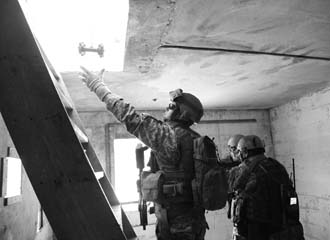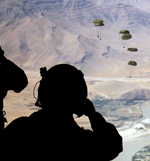Urgent Warfighter Needs Trigger Rapid Response
 |
A soldier throws a Recon Robotics-Recon Scout Throwbot XT robot. The 1.2-pound, barbell-shaped robot provides forward-positioned cameras able to capture images from dangerous locations. It is one of three throwable robotic systems being tested in Afghanistan to meet a critical need for warfighters. |
It is no secret that the Pentagon process for acquiring technology can be a long, cumbersome slog. But sometimes warfighters need something, and they need it now to save lives or gain an advantage over the enemy. In those cases—hundreds of cases—the rapid acquisition process can deliver capabilities weeks, months or even years quicker than the traditional routine.
Whether it is a critical need specific to one service or a joint need involving multiple services or agencies, the procedure is much the same. In either case, it begins with the warfighter in theater identifying a crucial capability missing from the arsenal and filling out a service-specific operational needs statement or a joint urgent operational needs statement (JUONS). The Pentagon’s Joint Rapid Acquisition Cell (JRAC), which falls under the Office of the Undersecretary of Defense for Acquisition, Technology and Logistics, has received about 500 such cases since the organization’s early days in 2005. “Right now we have about 100 individual requirements that are open and in some state of resolution. It’s not a steady battle rhythm. We can go a month without getting any requirements, and then some weeks we’ll get three or four new requirements. It comes and goes with the operation and the environment in theater,” explains Thomas Dee, JRAC director.
The Rapid Acquisition Authority provides the Pentagon with up to $200 million in any given year to meet urgent requirements, and it has some flexibility in moving funds while remaining in compliance with the same legislation and regulations that affect traditional acquisition programs. “For the past three years, we’ve moved about $3.5 billion through those methods in order to get money towards things right now that need to get done,” Dee discloses.
The JRAC has been instrumental in fielding a wide array of capabilities from ballistic protection for individual soldiers to intelligence, surveillance and reconnaissance systems, including aerostats, which have become essential in providing situational awareness in Afghanistan.
“Less than two years ago, we had fewer than 10 aerostats in Afghanistan. Now, we’ve got well over 60, and we’re on our way to more than 100 by the end of spring in order to provide coverage pretty much over every forward operating base that we’ve got in Afghanistan,” Dee says.
Once a need is verified and validated with the Joint Chiefs of Staff, the JRAC looks for time-saving measures at every step of the process, from defining requirements, to finding funds and actually acquiring the system or capability. “It’s important to emphasize that delivering a capability is more than just the acquisition piece of it. There can sometimes be as much time taken on the requirements side to really figure out what it is that the warfighter wants. What we do is compress all of that hopefully into less than a year from the original identification of a requirement from a warfighter in theater until a capability has actually been delivered,” Dee asserts.
He cites as two JRAC success stories: the Boomerang sniper detection system and an improved Joint Precision Airdrop System, which is a family of Global Positioning System-guided parachutes. When an urgent need came through the JRAC for a sniper detection system, the U.S. Army’s Boomerang program already was underway, but the system was nowhere near being fielded. “It was an existing program, but we didn’t have the money. Nobody had budgeted the money because we hadn’t anticipated that requirement. We had a requirement for hundreds of these things, so we needed to find some cash in a hurry,” Dee reveals. “We worked with the comptroller to use the rapid acquisition authority and move about $90 million in order to provide this capability.” The Defense Department found funding in January of last year, and the contract was awarded the following month.
Of course, snipers are not the only problem vexing warfighters. Troops at many remotely located forward operating bases have been dismayed to find that their air-dropped supplies landed too far away, requiring dangerous search missions. The situation resulted in an urgent need for a more precise Joint Precision Airdrop System. “We do a lot of airdrops to these remote sites, but the capability we had did not give us the precision that we want. The guys at the forward operating bases don’t want to go out and search for cargo drops,” Dee explains. “We gave that to the Army to execute, and the Army in very short time managed to improve their accuracy to within a hundred meters. Within seven months of the identification of that requirement, the Army delivered more than 100 units to improve the recoverability of supplies, reduce the number of supply convoys going out and reduce the risk.”
 |
Staff Sgt. Derek Howard, USAF, an 816th Expeditionary Airlift Squadron evaluator loadmaster, watches cargo bundles delivered using the Joint Precision Airdrop System fall over a drop zone in Afghanistan. The system has been improved through the urgent needs/rapid acquisition process. |
In June last year, the Pentagon formally centralized its urgent needs projects under one office—the Warfighter Senior Integration Group, which had its roots in the Counter IED Senior Integration Group and is co-chaired by the undersecretary of defense for acquisition, technology and logistics and the director of operations for the Joint Chiefs of Staff. “There are a lot of activities within the department. Each service has an effort for urgent needs. You have JIEDDO, and the ISR Task Force and others,” explains Dee. “It doesn’t matter if it’s a $100 million effort or a $500,000 effort. We’ve got all of the major stakeholders in the building sitting around the table and looking at these requirements and agreeing on the priorities and getting things done. We have a pinpoint focus on warfighter needs.”
He adds that warfighters reap the benefits when senior leadership is focused on urgent requirements. “We discovered it’s almost magical what you can do with the right level of priority on anything. It’s amazing how much stuff you can get done,” Dee says.
The Pentagon isn’t the only organization centralizing the urgent needs process. The U.S. Army’s Program Executive Office Command Control Communications-Tactical (PEO-C3T) recently has taken similar steps, according to Tony Morales, systems acquisitions specialist, within PEO-C3T’s Readiness Management Division. Last year, Morales was chosen to coordinate and track the PEO’s urgent needs statements. The office was assigned about 50 Army-specific operational needs statements last year, and as of November, had completed more than 30.
Morales divides warfighter requirements into two categories: those requesting more of an existing capability and those requiring some degree of development. He tracks the status of the urgent needs statements using the Equipment Common Operational Picture, a Web-based tracking system on the Secret Internet Protocol Router Network. “That gives me a good status of the operational needs statements that are out there, and when one is assigned to PEO-C3T, I alert the program managers,” Morales explains. He adds that centralizing the process provides greater visibility, collaboration and efficiency.
The PEO-C3T office has fielded the Harris AN/PRC-117G radio, a wireless multimedia radio that allows troops to exchange large amounts of data, including video and biometrics information. The office also has fielded to Afghanistan and Iraq the Mission Command On-The-Move system, which is integrated into a variety of platforms, including Bradley, Stryker and Mine Resistant Ambush Protected vehicles. It supports mobile mission command requirements for brigade, division and corps levels and more recently has been pushed down to the battalion level.
Additionally, the office has delivered to U.S. Army Africa a Mobile Contingency Command Post, which is a low-profile, mobile command post that offers access points to the Defense Department’s secret and sensitive networks, as well as video and radio systems.
“We’re currently working on a JUONS for a distribution management common operating picture, a new system to track a shipment of cargo in and out of Afghanistan by both military or commercial air, sea or land transportation,” Morales reports. “It’s a big undertaking.” He adds that the Army is working with the Air Force on the program.
The Army uses its Network Integration Evaluation (NIE) exercises to assess many of the systems that may fulfill an urgent need. The NIE events take place every six months. The service has committed 2nd Brigade Combat Team, 1st Armored Division, to evaluate new technologies and network capabilities. The units consist of more than 3,800 soldiers organized and equipped to replicate heavy, light and Stryker formations. These soldiers work with systems or technologies and provide feedback.
“What we’re trying to do with the NIE is to figure out how best to use current technologies and upcoming technologies,” says Doug Tamilio, PEO-C3T deputy chief of staff. “We want to speed up the acquisition process so that we can get relevant equipment into the hands of soldiers today versus waiting four or five years.”
WEB RESOURCES
JIEDDO: https://www.jieddo.dod.mil
PEO-C3T: http://peoc3t.army.mil/c3t




Comments